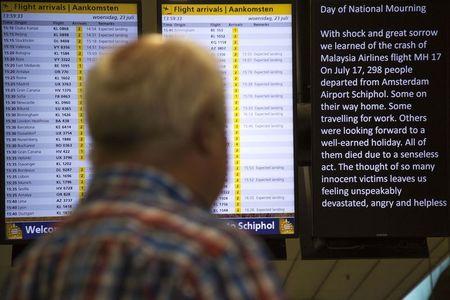EINDHOVEN THE NETHERLANDS - The bodies of the first victims from a Malaysian airliner shot down over Ukraine last week arrived back in the Netherlands on Wednesday amid dignified grief tinged with anger.
Bells pealed and flags flew at half mast in memory of the 298 people killed when flight MH17 crashed in an area of eastern Ukraine held by Russian-backed separatists, in the first national day of mourning since wartime Queen Wilhelmina died in 1962.
King Willem-Alexander and Prime Minister Mark Rutte led dignitaries on the tarmac as two military aircraft carrying 40 plain wooden coffins landed at Eindhoven Airport in the southern Netherlands.
A military honour guard stood to attention as a lone trumpeter played The Last Post, the military funeral call for people killed in war.
After a minute's silence - observed in stations, factories, offices and streets across this stunned nation - soldiers and marines boarded the Dutch Hercules C-130 and Australian Boeing C-17 to carry the coffins to 40 waiting hearses lined up on the runway.
Relatives of some of the victims were present at the airport but were shielded from the media glare, officials said.
Amid U.S. accusations that the rebels shot the civilian plane down in error with a Russian-supplied missile, an opinion poll showed an overwhelming majority of the Dutch want economic sanctions imposed on Moscow, even if it hurts their own economy.
Windmills around this low-lying coastal nation were set in a mourning position and church bells tolled as the planes carrying the remains arrived from Kharkiv, in eastern Ukraine, shortly before 4 p.m. (1400 GMT).
The remains of an unknown number of victims were transported in refrigerated rail carriages from the rebel-held part of Ukraine on Tuesday. Rutte has said that while some of the bodies may be identified immediately, it may take weeks or even months to complete the grim task.
Shock and sorrow
With 193 of the dead from the Netherlands, Foreign Minister Frans Timmermans said almost every family in the country of 15 million knew someone who died or their relatives, contributing to a national mood of shock and sorrow.
"Think of all the people who were flying away on holiday, all the young people who had just finished their final school exams," said Jikkie van der Giessen from Amsterdam.
"They were looking fully toward the future and then you're shot down. Whether it was an accident or on purpose, the fact is it's horrible," she said.
Many of the passengers on the flight to Kuala Lumpur were tourists, but at least six were AIDS experts on their way to a conference in Melbourne, Australia on the deadly disease.
Representatives of the many countries whose citizens died in the crash were present at the airfield, including the governor-general of Australia, Peter Cosgrove. Their flags lined the airfield at half-mast on a cloudless day.
Trains came to a stop for a minute as the country observed a minute's silence. No planes took off or landed at Schiphol Airport, from which the Malaysian Airlines flight departed, for 13 minutes around the time the bodies land.
A silent memorial rally was planned outside the royal palace in Amsterdam's Dam square on Wednesday evening.
With so many of their countrymen dead, the Dutch have been taking a leading role in the international effort to recover and identify the bodies and investigate the cause of the crash.
Dutch authorities are leading the investigation, with extensive help from other countries. The plane's black box flight recorders, handed over by the rebels' leader, were flown from Ukraine on a Belgian military plane on Tuesday to Britain, where a team of experts will examine them.
From Eindhoven, the bodies were to be driven in a convoy of hearses to a military barracks near the town of Hilversum, where forensics experts will begin the painstaking work of putting names to the remains.
Australian Prime Minister Tony Abbott said it was unclear how many bodies had been transported to Kharkiv and how may have been left behind at the crash site.
Rutte, thrust into an unaccustomed spotlight, said on Tuesday the disaster had fundamentally changed the way the Dutch view Russia, urging the European Union to unite behind a firm approach to force Moscow to cooperate with the probe.
He has spoken almost daily with U.S. President Barack Obama, Russian President Vladimir Putin and other European leaders to coordinate the return of the bodies and discuss the investigation and the consequences.
With U.S. intelligence pointing to the aircraft having been shot down accidentally by the Moscow-backed separatists, the Dutch mood of sorrow is starting to be mixed with indignation.
The poll published in the daily De Telegraaf said 78 percent of the Dutch would be prepared to impose punitive sanctions on Russia even if it hurt their own economy.
The Netherlands has disproportionately large trade and financial flows with Moscow due to its position as an oil and commodities trading hub and an offshore base for companies.
The loss of life has few parallels in recent Dutch history. More than 200 Dutch citizens died in the 1977 Tenerife airport disaster, in which two fully-loaded Boeing 747s collided on the ground with the loss of 583 lives, the world's worst civil aviation disaster.
The worst post-war disaster in the Netherlands occurred in 1953, when the North Sea flooded low-lying eastern areas one stormy night, sweeping over dikes to take more than 1,800 lives.























































